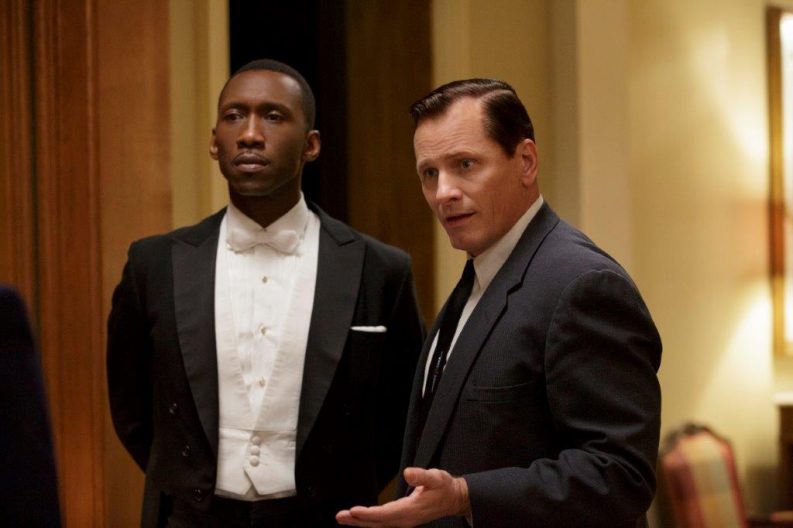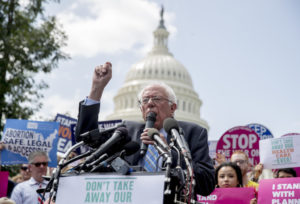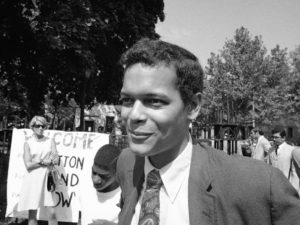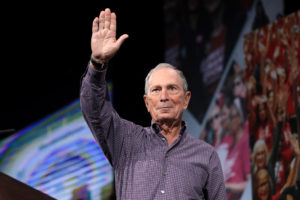Hollywood’s Love Affair With Racism
When it comes to matters of race, the entertainment industry fails its increasingly diverse audience time and again. Mahershala Ali and Viggo Mortensen star in "Green Book" (2018). (Universal Pictures)
Mahershala Ali and Viggo Mortensen star in "Green Book" (2018). (Universal Pictures)
Listen to their discussion to learn more about what Hollywood is getting both right and wrong about what Americans want to see on their screens. You can also read a transcript of the interview below in the media player.
Robert Scheer: Hi, it’s Robert Scheer with another edition of “Scheer Intelligence,” where the intelligence comes from my guests. In this case, two well-known sociologists, the chair of that department at UCLA being Darnell Hunt, and the director of research, Ana-Christina Ramon. And the reason I wanted to have you here this week is because of the controversy about the Oscars. And you know, we have these periodic things, #OscarsSoWhite and Oscars inclusive. And there’s no question mass culture is important; it sets values, it determines attitudes, it influences reality in dramatic ways. But did we make too much of the Oscars this time? Is there really big change? And you guys have produced a report, the sixth annual report that you have on diversity. And it had a snappy title: “Old Start, New Beginning.” So why don’t you just tell me, what’s going on? Is this a new day, a new market? And I should hasten to add that your studies are important, because you center on what sells, what finds an audience. And one of the things that stuck out for me in that report is you’re suggesting that with the new ways of distributing digital media, with the role of Netflix changing the market, we’re no longer with the old studio system, there’s room for diversity, because you’re trying to get a diverse market.
Darnell Hunt: Well, first of all, I just want to say thanks for inviting us, Robert. We’re really happy to be here to talk about the work we do at UCLA on this study. First I just want to let you know that I’m the dean of social sciences, and Ana-Christina Ramon is the director of research and civic engagement for the social sciences. And the report is now produced every year out of the Division of Social Sciences. It originated in the Bunche Center five years ago, six years ago, but it moved over a couple of years ago. So what we try to do, basically, is gain a sense of what’s happening in the industry to develop some comprehensive, reliable, objective numbers that allow us to track from year to year whether or not we’re actually making progress. Prior to our study coming out back in 2014, which was the first year, you know, there was a lot of talk, and a lot of it was anecdotal, about well, Hollywood’s getting better, it’s getting worse. And it was hard to really put your finger on what was happening without a firm kind of frame of reference that looked at everything. And we look at pretty much everything that’s in the TV pipeline, so this year we looked at over 1,300 TV shows–believe it or not, there are that many. [Laughs] When you start counting broadcast cable, digital platforms, scripted and reality and other programming. And then we look at the top Hollywood films. We rank them by box office, and we look at the top 200 films, and we subtract out foreign-language films, which usually leaves us around 170, 175 films each year. And the basic question we ask is, first of all, is diversity in front of and behind the camera increasing, going backwards, or staying the same? And then the second question we ask, which we think is actually the most important question, is what is the relationship between the level of diversity we see on the screen, and the bottom line? That is to say, movie box office, and ratings in television. And what we’ve found for six years straight now in our series is there is a relationship, and TV shows and movies that look more like America–that is to say, that are roughly 30 to 40-something percent diverse–on average do the best, in terms of box office and in terms of ratings. And that stand to reason. I mean, America right now is nearly 40 percent people of color. That share is growing by about a half a percent a year, and in a couple decades we’re going to be majority minority. And all too often in Hollywood there’s been this belief that, you know, you have to cater to the mainstream audience, which was understood to be the white audience, in order to make profitable movies and TV shows. And so what that meant is, over decades we saw the majority of TV shows and movies with white leads, men dominating in terms of the major roles, the lines–I mean, all the different ways we determine who’s prominent in a TV show or a movie. And increasingly, there’s been a disconnect between what Hollywood was producing and what audiences were wanting. And so this is what we found in our study series, that you can actually discern the tastes of audiences of color, of women, and there’s some really clear patterns. And increasingly, people of color are flexing their muscle, really, at the box office and in terms of TV ratings. Because we get data on ticket buyers; we also have data on, from Nielsen on ratings and social media engagement with TV shows. I’ve probably talked much too long. [Laughter] I’ll turn it over to Ana-Christina, do you want to [talk] about the report?
Ana-Christina Ramon: We found that people really do want to see the real world reflected on screen. The biggest groups that are really consumers of media are Latinos for film, and African Americans for television. On a per capita basis, people of color really are a driving force in terms of the purchasing power that they have in the industry. And I think for a long time, Hollywood has ignored that. And so now they see that that is something that they should capitalize on, and they’ve been able to capitalize on it in some ways with television. Because they finally saw, like a show such as Empire, that they were for too long taking for granted the African-American TV audience. And so then they finally saw that they could make a show that would get really high ratings. The ratings for that show in particular have been one of the highest ratings in the past couple of reports that we’ve had. And so it just shows that the audience of color is really an audience that, you know, needs to get the attention and needs to be reflected in what the TV shows and the movies that are being produced.
RS: Everything you’re saying is obvious, and since these are businesses they should have known this all along, they should have gotten with the program. And I’m thinking of the analogy with professional sports, where we’ve experienced a great deal of discrimination. I know the Lakers when they came to L.A. for a convention, the rule in the NBA was two black players on the starting team was all you could handle. And you know, of course, we had segregation in sports for the longest time, despite a fan base out there. And you actually have come up with the football rule, the Rooney Rule, as one of the solutions that you think explains how opaque Hollywood has been on this issue. That there isn’t enough inclusion and involvement in the decision-making on the highest level.
DH: One of the things we talk about is we–I’m a sociologist by training, and so I’m very interested in structures, in how things are structured and how that produces particular types of outcomes, despite what individuals may intend to do. One of the things we know about the industry is that for generations, really from the inception of the industry, it was a white, male-dominated industry. It’s an industry that’s sort of patterned by comfort levels, people hiring people with whom they’ve worked before, they feel comfortable with; it’s a high-pressure, high-intensity, you must meet the deadline type of industry. And the tendency was for people to almost by, you know, sort of routine reaction, surround themselves with people that they knew they could go to really quickly, who kind of think like them and often look like them. And so what you got was a reproduction of white, male culture in most of what Hollywood produced. That is to say, the white men were the protagonists, they were the leads; the women were there to service them or to serve as companions. And you know, when a woman character was developed, it was often second to the male character, and so forth and so on. And the same was true for people of color. Anyone who wasn’t a white male was kind of “othered” in interesting ways within the ecosystem of the movie or the TV show. That was the typical, traditional Hollywood pattern. It “worked,” you know, and I’ll put that in quotation marks, because demographically America was overwhelmingly white throughout much of its history, particularly if you think of the rise of cinema at the beginning of the 20th century, and then the introduction of TV in the 1940s, 1950s. But all that began to change as America itself, you know, started increasingly becoming more diverse. In fact, when you get to a point like where we are today, where 40 percent of the population is people of color; women have always been, you know, half the population or slightly more than half the population; you get to the point where the white male dominant culture just doesn’t work. Audiences don’t want that, and they demonstrate that if you look at the top 10 shows by race of household, for example, or if you look at shows that women prefer over shows that men prefer. Usually people prefer shows where the lead character–that is to say, the character whose story it is–they can relate to. And if all of your stories have white men as leads, well, the white men probably feel pretty good about that, but everyone else is like well, you know, I’m looking for something in this show that I can relate to. So maybe there’s another character in there that looks like me, or kind of looks like me, and I like it for that reason. There’s a joke that black people told, you know, throughout most of the history of television, like you know, we would run to the phone and call someone if there was a black person on television. Because like, gee, this was like an unusual occurrence. Well, we’re beyond that point now, obviously. But that was much of the history of American television. And it was the same for Latinos and Asian Americans and other groups who were underrepresented, or in some cases invisible. Like Native Americans, to this day, you can barely find them on TV or in the movies.
RS: Well, that brings up a point I want to–I want to talk about the educational role of mass media in this. I think there’s an obligation for Hollywood, and it extends beyond inclusion; it’s really dealing with justice. You mentioned Native Americans; well, Native Americans–the destruction, the genocide of Native Americans was endorsed by Hollywood, celebrated by Hollywood, you know. And the fact of the matter is, if you go right through, we had the depiction of people as the other, meaning you didn’t have to care about them. The irony with Hollywood is that was even done towards Jewish people. And even though this was an industry dominated by Jewish studio heads, there was no discussion of the rise of fascism, the role of antisemitism. And Jewish people were actually told to change their nose, change their look, change their name, certainly. So what I want to get at is that the role of this mass media traditionally was not only to ignore the other, it was to affirm the dominant values of the society.
DH: Well, that’s exactly right. I wouldn’t say it’s a one-to-one relationship, but there’s a close relationship to American culture and American politics, if you look at it decade by decade, in terms of what the major genres are, what the major themes are. You know, during the Cold War there was a particular type of movie that was made. And Hollywood often reflected that, with something of a lag. Again, it wasn’t perfectly in sync, because it takes time to develop movies and TV shows, but there is a relationship. And the people who, you know, work in Hollywood are people too. They are subject to the culture, they’re subject to their unconscious biases, and all these other factors that caused them to say hey, that’s a great idea, let’s develop this, let’s turn it into a movie or TV show. And all of the stereotypes that have been used to demean different groups throughout history often found their way into Hollywood movies, particularly when the people who were the subject of the stereotypes didn’t have any power in the industry. So that’s very common, and Native Americans are a classic example to this day. Now, some groups have been able to advocate for themselves, and they’ve been relatively effective at forcing the industry to include them a little bit more. Say African Americans; I mean, African Americans are often perceived by other underrepresented groups as like the–I hate to use this term, but the model minority with respect to Hollywood. In the sense that in some cases, African Americans were actually overrepresented in television, that their share of TV characters was larger than their share of the overall population. But if you start looking at the quality of those representations, the images and the stereotypes that were still embedded in them, you can see all the problems associated with an industry that’s telling stories about people when those people don’t have a role in the decision-making process.
RS: As one example of this, let’s take one of the more recent controversies, the Green Book movie. And it’s been criticized from a number of different ways, and they all have validity. And the question the film avoided, and this is true of a lot of mass media, is the responsibility. Historical responsibility. Because after all, this was the early sixties. This is after World War II, now; this is after the beginning of the Civil Rights Movement. And yet, the movie avoids the question, why was this the norm for these otherwise decent, reasonable white people? How did they accept it? Why did it take an alienated hood from the Bronx to somehow be the buffer? And so, OK. At this moment people will be groaning, and they’ll say well, you know, a movie can only do so much. This is why I bring up the question of cultural reparations. Because I don’t think it’s enough to, you know, whether you’re talking about gays or you’re talking about Asians or you’re talking about women, or any group that’s been marginalized, discriminated against, exploited. If you don’t give the history, then they just seem like whiners.
DH: There’s a tendency within the history of Hollywood to sort of turn every conflict into an individual conflict. Because then you can kind of develop a narrative and a dramatic arc that, you know, drives the movie or the TV show. And so Hollywood loves these buddy films. It’s even better when you have a black and a white buddy, and the white buddy is kind of the stand-in for the white audience, who becomes the hero. And in fact, that’s one of the criticisms of Green Book, that it’s really the white character’s story. In fact, Mahershala Ali, you know, he gets Best Supporting Actor even though it’s a story about black people in the South and the Green Book. You know, which is in a way kind of ironic, given the history of Hollywood and the way these things work. So certainly, there’s been this tendency in Hollywood to avoid history. It’s hard to tell historical stories, and it’s much easier to revise history and to kind of oversimplify things into these conflicts between individuals. Because that lets kind of our culture off the hook; it sort of conveniently sanitizes the culpability the nation as a whole may have for certain types of things. And it’s more of a feel-good proposition for people who don’t want to face those types of issues.
RS: [omission for station break] I want to cut to a question you just raised on responsibility, and that goes to the reparations question. And that is, if we just take people as this shot of time now, why are people in a certain state of affairs? Why don’t the schools work better, say, in Oakland or in L.A.? And if there’s no historical context, let alone an assessment of the responsibility of mass media for that state of affairs, you miss the whole point. The recognition goes to Donald Trump’s, you know, “make America great again,” and Hillary Clinton’s “America’s always been great”–no! It wasn’t always great, and it wasn’t great before. And the refusal to take on that question–that’s what bothered me about the Green Book. Why was there a Green Book in the early 1960s with the Beatles coming along–what are we talking about? What is this about America? To my mind, the real problem with Hollywood mass culture is they’ve always wanted at the end of the day to celebrate a feel-good story about America.
ACR: The thing is, Hollywood often embraces a colorblind approach. So the colorblind approach doesn’t work in the real world because studies have shown that if you’re in a company and you have a colorblind approach versus a more multicultural approach, a colorblind approach fails. Because when you just tell everyone that, oh, we’re all the same, we don’t look at race, then you just kind of negate the struggles that people of color have experienced. And it’s really a way to make white people feel good about the state of affairs, when you know, most of the time people of color are the ones that are having to then deal with racism, deal with everyday experiences of discrimination, and institutional racism itself. And so that’s, I think, something that is perpetuated with Hollywood stories for the most part. They just have this idea that, oh, we’re all the same deep down; we can just all be friends regardless of all these other issues that are going on in our society. So I think that that is a letdown, because in this day and age, for a movie like Green Book to really ignore, like you said, the history of why the Green Book was created and needed, then, really doesn’t do service to what needs to be understood. And kind of like what you said, I guess, that it makes people look like whiners now, if you know, you say well, there is still institutional racism. There is still discrimination. You know, and then people think well, you know, these images that I see make it seem like everything is OK, because we can all get along in the end, and why is it such a big deal, why are you complaining.
RS: Yeah, I think that’s a critical point, and it goes to this focus on Hollywood, which we have to recognize. There is mass culture, it shapes people’s attitudes, I’m not taking anything away from your study. But one of the problems is you run into this, you run into two issues. One is class, and the other is celebrity. Hollywood tends to stress the success. Looking for the ideal role model, and then denying the reality that other people face. You know, the lack of jobs–so for instance, the population of African Americans in California has declined, and it declined because the kind of opportunities, the kind of jobs, the kind of training, the kind of skill set went away. And there’s no recognition of that. So I just want to get some sense, because you guys are working in this area, are things getting better? Quite apart from where Hollywood is, what is going on?
DH: The founding fathers of sociology, my discipline, you know, they predicted that race was sort of like a byproduct of other, more significant processes, and as societies modernized, it would just go away. Well, they were all wrong. W.E.B. Du Bois, of course, his famous line at the beginning of the 20th century is that race, you know, will be the question of the 20th century. And in fact, it was. But it’s been far from resolved. The color line, as he put it, remains a key organizing feature in our society. Part of the problem is that we live in a society where you have large degrees of inequality, and structures are in place to maintain order by trying to stabilize the various groupings of people you have into different classes, into different races, so that elites who control things aren’t as vulnerable to, I guess, challenges of their authority as they might otherwise be. It’s a lot easier to keep people fighting with one another, and vilifying each other, than focusing on the people who really control things. And so we’ve had ideologies like the American dream, for example, which argues that, you know, you work hard, you develop yourself, you can do better than your parents’ generation; in fact, you know, there’s nothing you can’t do. Well, of course that’s false. In fact, all the data show now that the current generation is doing worse than their parents did, because we’ve had economic decline in this country. And it’s disproportionately affected different groups; you know, racialized groups have a much harder time, and so forth. So a lot of the tensions we have in society, a lot of the debates we have about race and everything else, are really masking these other, larger, fundamental, underlying inequalities that have always plagued our society. I mean, you can go back to the constitution; it was free, white, property-owning men. You know, who had the, who could vote and who had the power, and only as we amended the Constitution were other people allowed participation, women with the vote and people of color at some point. And you know, even then, I mean, we had need for civil rights acts in the early sixties, and voting rights acts, and things like that. And then we took steps backwards. I would say that we’re in a period right now that is challenging a lot of the progress we’ve made throughout our nation’s history. And it’s not accidental that these challenges are happening at the same time that demographically, that we’re moving towards majority-minority status. So there are lots of things happening, so I think your original question is, well, why are we still dealing with these issues? Because of the fundamental fact of inequality, and of our inability to live up to the ideal of being equal. And what that really means in terms of distribution of resources, access to power, and all the other things that would have to happen for people to really realize that ideal. And all the tensions we face are around those basic issues, and we’ve had this never-ending pattern of taking a few steps forward and then taking a few steps back. All the urban uprisings we had at various points in our history were a backlash or a reaction to too much progress in the eyes of certain people. And I think what we’re dealing with right now politically; I mean, the question is, are we going to have a backlash from the other direction based on sort of the excesses of the current administration and the political position. It’s hard to predict, of course, you know, with any certainty what’s going to happen. But things are very volatile for that reason.
RS: So I want to ask you, end on a positive note. Because in your study you point out that there’s a fragmentation of the market, Netflix and all this sort of thing, Amazon and what have you. So you talk about sort of new opportunity for smaller budget, for finding different audiences. And there were two very powerful movies that I happened to see up in Oakland, California, made by local people. One was sort of an attack on the mass marketing, gig jobs and everything, and one is on racial identification of a different kind, in Blindspotting and Sorry to Bother You. They were, I thought, both brilliant films. And they could find an audience. And what I’m wondering about is whether this is not going to be the beginning of a different way of making movies. That they can then delve into class, which both of those films did; how do you actually make a living if you’re not especially talented in some way athletically, or if you don’t have nurturing parents from day one, and good opportunities and so forth. And I just wondered whether you have any sense that the industry itself will fragment in much the way the internet has fragmented the newspaper industry, a lot of journalism, which you studied here at USC. And whether that isn’t going to be the beginning of a new day.
ACR: I think that it definitely is a sign of a new day in terms of movies, in terms of TV shows that you can see on any kind of device, mobile device nowadays. The issue, though, is distributing those movies, being able to distribute, being able to get the financing. Those are still barriers to getting more people to see that art, to see the reflections on the culture. And so those are still going to be, I think, difficult for people of color who are filmmakers and who are creators of content.
DH: Yeah, finding an audience, that’s key. And obviously the larger, multinational conglomerates that own the networks and studios, they, you know, are like an oligopoly. They have market power in terms of being able to drive potential viewers to their programming because of their advertising and marketing budgets. And to the degree that net neutrality comes under attack, drive traffic to their websites at faster speeds than independent producers. I mean, a lot of these people with YouTube channels now, producing interesting, web-based, scripted series, are in jeopardy of losing their audiences or losing a large proportion of their audience, if we did lose net neutrality. So these are all question marks that are going to define the possibilities going forward. But I think that the new beginning that we refer to is the fact that TV, because of the change we’ve seen in TV in recent years because of changing technology, streaming video on demand, et cetera, has provided us with a model for what’s possible. I mean, the fact that there’s so many more original programs being created, new talent that never got a shot before, because they have to fill the space and they can’t keep going back to the same white male producers–it’s shown people what’s possible, it’s given audiences a taste of what they could get, and they’re not going to go back. They’re going to demand that in the future. So the question is, how will that play out and how will the industry respond?
RS: OK, so let me end this on–I tried being positive, let me be a little bit depressing. You know, in California we had a very significant black community, let me just single that community out. And I want to talk about the migration that was accompanied by World War II. And what you had, really, was the land of opportunity; you had new industrial jobs and aircraft and the defense industry generally, and longshore and so forth.
DH: Yep. By the way, the two of us actually co-edited a volume called Black Los Angeles.
RS: And yeah, so asserting as a documentable fact that there was this sort of the American dream becoming a reality out of necessity. The same reason women entered the workforce. What we see now is winners and losers. And some of those winners can be people of color, and they can be women, and so forth. But sitting here at USC, and I’m going to go teach a class now after we do this–we have a steady pattern of information distributed to our students about the crime rate. It’s mandated by law, and it’s a five-foot-ten Latino of some sort, or a six-foot one, African American, snatching a cell phone, this prized possession, you know, doing something of that order. And that’s the other. And that’s a lot of the people who live around here, and we’ve gentrified part of the community, but the rest are pushed away, and they can’t afford the prices in the gentrified area, you know. And much of America is now gentrified within the cities, and so forth. And the odd thing is, the only thing that connects all these people could be mass media. But if mass media does what you have suggested, that it wants to tell a positive story about America, it’s going to miss that story. This is an interesting question about art, because after all, the challenge of art is to make us look at the thing that makes us uncomfortable. Or establish the humanity of the other We get it a little bit with the documentaries, but generally, we get a feel-good narrative. And I just want to ask you people as sociologists now, are we moving to a two-society world here, in which there is this group that are just to be ignored, expendable, contained, and imprisoned–and then you have this industry that you guys analyze, in which whatever your color, if you make it, you’re suddenly in that rarefied group of winners? What do these stats show? I know we have stats here at USC, we have Stacy Smith’s great project in diversification, and you have at UCLA and so forth. What do they tell us about class?
DH: Well, first of all, most people in America think that they’re middle-class. And you know, most of our political tropes are always couched in language talking about what is good for the middle class. What that does is sort of mask degrees of inequality we have in our society, and most notably the fact that the top, you know, one percent owns more than the bottom 99 percent in terms of wealth. That’s really ridiculous in a society that thinks of itself as a democracy and as a land where people are equal and free to pursue their own pursuits. Because what it sets up is such profound power imbalances that people can’t adequately participate in their democracy. They can’t advocate for the types of programs that would cater to the least in society in the way that we should, in the measure of a great society. So class is one of those things that we don’t really like to talk about a lot here. You go to the U.K., and they talk about class. But they also have, you know, a safety net where they have, you know, universal health insurance and all the other types of things that we don’t provide, or people are reluctant to provide in this country. It’s why we’ve been debating healthcare for decades, and why that was a huge issue with the last midterm election and the 2016 election. It’s something that has been exploited by elites to sort of make it harder for people to challenge their position in society. And so we’ve used race, which often masks class differences. We’ve used ethnicity, we’ve used immigration status, we’ve used all these other types of things to make it harder for people to form coalitions from similar classes to advocate for what they deserve as citizens of a society, because they’re fighting over these other identities or differences that are very real, because of the way our society is structured. So that’s the conundrum I think we find ourselves in in this country, that many of our allies in Europe and other places have done a better job dealing with. I mean, they have their own racial problems, too. I mean, particularly when they have new immigrants coming in from Africa and other places, suddenly those racial issues arise as well. But I think it’s really extreme here, in terms of our ideology as a nation and the way we think of ourselves, and the types of things that we just don’t talk about and we don’t deal with, and class is one of them. You’re right, the income inequality has grown; it hasn’t gotten better, it’s grown. The wealth differences have grown over time. And we’re at a point now where the elite, I mean someone like Jeff Bezos for example, I mean–can you imagine? You’re worth more than nations. How can that happen in a democracy, and what are the negative, the fallout from that? But we live in a country where we believe in the winner-takes-all, that you know, if you’re smart enough and industrious enough, or through whatever tactics you use to be able to amass wealth, there’s no limit on what you can do. And you have minimal responsibility to account for that; people avoid taxes, they don’t pay taxes, or they pay, their tax burden’s a lot lower than what it should be. And they try to obfuscate what they’re doing to the country by saying oh, but we’re philanthropists. But that’s a much smaller amount than you would be paying in taxes, and you’re also unilaterally saying, this is how I’m using my money and this is what you have to do with it. Which is different than participating in a democracy. So that’s one of the huge issues that we face.
ACR: I think that widening wealth gap has created like generational inequality–so for, especially for people of color, then, it’s harder to get out of that, right. But also for poor white people, you know, as well. And I think that with the changing demographics, just like, probably with like the last election, I think that race does become an issue. Because it’s easy for certain politicians, they scapegoat people of color, and immigrants; that way they can just blame it on, like, oh, well, you’re not poor because of something that the policies that have been enacted, or the way that the government has been just enacting certain policies. They just blame it on, like, oh, it’s because these other people are taking your jobs. And so I think that that has created, then, this environment where, again, like what Dr. Hunt was saying, then people are just fighting amongst themselves instead of coming together and uniting against, like, a common force that they could be working against to make things more equal for everyone
RS: When we try to study mass media, there are things that are easy to count. You know, gender, race, and number of positions–and they’re all important. The hope, however, is that with greater representation, greater diversity, you’ll also broaden your perspective.
DH: Oh, absolutely. Yeah.
RS: And that will extend to class. And what bothers me about the focus on the Oscars and on Hollywood and everything, it’s this lottery of the super-successful. And it doesn’t translate into an understanding, a concern for people who don’t make it that well, who don’t become famous. This whole sensitivity of the enterprise, which you guys are monitoring, is really an affirmation of the distinction, the moneyed distinction, that now overwhelms the society.
DH: Well, one of the reasons that I’m cautiously optimistic about where we’re headed, at least in television–I mean, the TV model, you know, commercial television in America has been about advertising, it’s about selling viewers to advertisers, basically. And traditionally what that’s meant for television is that they had to create a buying mood when you watch the show. And so that meant that there was always a skew towards relatively affluent families, in nice suburban homes, with lots of consumer products. Because that’s what you’re selling in the commercials. And that’s always been sort of the basic default of commercial television. There have been exceptions; Roseanne, you know, the TV show, and there have been a few others where they featured working-class families. But those are exceptions to the rule. What’s different today, though, with streaming video on demand, it’s no longer based on advertiser ratings. It’s based on subscriptions to consumers who buy access to Netflix, Hulu, or Amazon. That gives the potential creators of programming a little bit more leeway, a little bit more degrees of freedom to produce shows that don’t have to appeal to advertisers, and to create that buying mood. So you can do stories about impoverished families or situations that don’t live in beautiful homes, and who are successful, you know, attorneys and doctors and that type of thing, that are more reflective of the range of experiences we have in this country. That’s a possibility, at least, and I think that if we are seriously committed to presenting a more balanced view of life, you have to show the good with the bad. You have to show the challenges with the triumphs. And every community has those. And so I’m a proponent for showing the warts as well as the successes. I’m African American; I wouldn’t want to see programs about African Americans where everyone’s a successful brain surgeon, and at the same time, we have no sense of what’s happening to lots of black people in inner-city communities. I want to see all of that. I don’t want to see all inner-city, or all, you know, super successful; I want to see a balance, I want to see a range of different experiences within the diversity of the experience we call blackness. Now, I would imagine that other groups want to see the same thing, and I think if we can do that, then we can start moving one step closer to presenting a view of America that helps us develop the perspective necessary to change things for the better.
RS: That is an optimistic point of view. Hopefully the industry can find profit by also being accurate in its depiction of society. We’ll see. But that is all the time we have for this edition of “Scheer Intelligence.” I want to thank Dr. Ana-Christina Ramon and Dr. Darnell Hunt, and they are from UCLA. And we are pleased to have you here at USC, where we’ve taped this. Our engineers at KCRW are Kat Yore and Mario Diaz. Our producers are Josh Scheer and Isabel Carreon. And here at USC, the great Sebastian Grubaugh has held the show together despite my fumbling throughout. Thank you.
DH, ACR: Thank you.
Your support matters…Independent journalism is under threat and overshadowed by heavily funded mainstream media.
You can help level the playing field. Become a member.
Your tax-deductible contribution keeps us digging beneath the headlines to give you thought-provoking, investigative reporting and analysis that unearths what's really happening- without compromise.
Give today to support our courageous, independent journalists.








You need to be a supporter to comment.
There are currently no responses to this article.
Be the first to respond.